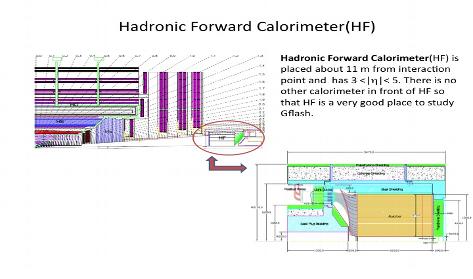We have developed HF GFlash, a very fast simulation of electromagnetic showers using parameterizations of the profiles in Hadronic Forward Calorimeter. HF GFlash has good agreement to Data and previous Test Beam results. In addition to good agreement to Data and previous Test Beam results. HF GFlash can simulate about 10000 times faster than standard simulation.

Previous HF Simulation (based on Shower Library) in CMS Collaboration has no ability to simulate PMT Window Noise and other noises. The worst part of the previous simulation that it was created using only discrete energy bins (10, 20 , 30, 40, 50, etc. not continuous) that limit its precision significantly. The HF Shower Library has another problem because it deletes particles that enter HF Detector immediately and replace them with Shower Library that has very limited statis- tics. Fortunately, we have developed HF GFlash, a fast simulation of electromagnetic showers using parameterizations of the profiles in Hadronic Forward Calorimeter. HF GFlash solves almost all problems of previous HF Simulation.
HF will experience unprecedented particle fluxes because on average, 760 GeV per proton proton interaction is de- posited into the two forward calorimeters, compared to only 100 GeV for the rest of the detector. Due to this condition, CMS has changed the HF geometry for simulation because it will need very long computing time if we use full HF ge- ometry for huge number of high energy particles. The new HF geometry does not include detail description of sensitive detectors in HF, but only general description of HF.
The previous HF GFlash code that we have developed since 2009 has to be modified and tuned to current geometry and condition. In fact, since we have collision data available, our understanding about our detector and physics at 7 TeV improved significantly so that we had to modify the way we deal with object reconstruction in CMS software(CMSSW). Now, we have modified HF GFlash in such a way that it has good agreement to Data and previous Test Beam results.
In addition to good agreement to Data and previous Test Beam results, we also have improve the speed of HF GFlash significantly.
One major breakthrough that we achieve last year is the ability of HF GFlash to simulate PMT Windows hits for the first time and previous MC Simulation can not simulate PMT Window Hits. This achievement, encourage us to simulate other noises such as Fibre Bundle and Jungle. The early results show that inclusion of PMT Window Hits, Fibre Bundle and Jungle improve the agreement between HF GFlash Data and 7 TeV Collision Data.
By the end of November 2010 we have collected about 37 pb−1 certified Collision Data that can be used to study RecHit(reconstructed hits) energy distribution in HF towers for Long and Short Fibres. Using MinBias generator we can simulate HF RecHit for every tower. We have made 52 comparison plots for every HF tower and we found the HF GFlash has good agreement with 37 pb−1 Certified Collision Data and we can see HF GFlash can perform better than previous MC based on Shower Library.
We compare the results of HF GFlash with Test Beam data and Shower Library(previous MonteCarlo used in HF in CMS)
| HF GFLASH | Test Beam | Shower Library | |
| Se/Le | 0.24 | 0.24 | 0.20 |
| Lp/Le | 0.67 | 0.66 | 0.63 |
| Sp/Le | 0.51 | 0.50 | 0.51 |
| Sp/Lp | 0.76 | 0.76 | 0.80 |
Le = Energy deposited in Long Fiber from 10000 50-GeV electrons
Se = Energy deposited in Short Fiber from 10000 50-GeV electrons
Lp = Energy deposited in Long Fiber from 10000 50-GeV charged pions
Sp = Energy deposited in Short Fiber from 10000 50-GeV charged pions
HF GFlash is ready for Super LHC and is prepared for ILC Calorimeter and you can get more information about its performance in The Technology and Instrumentation in Particle Physics 2011 (TIPP 2011).